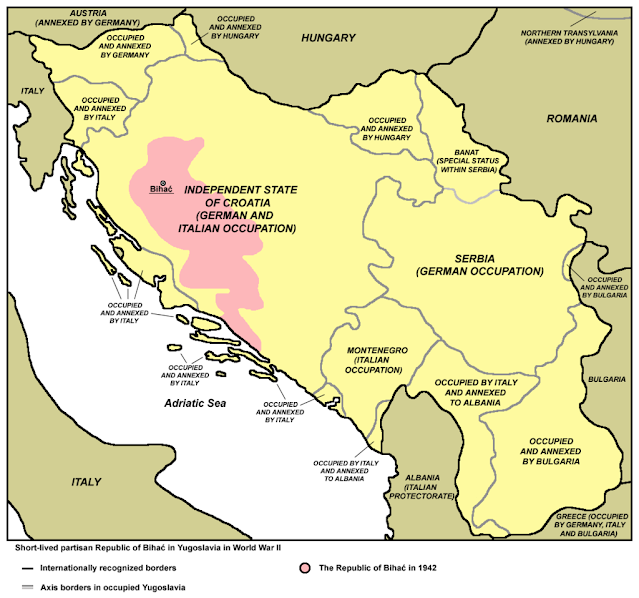"Tito's state" in the heart of occupied Europe - Republic of Bihać
 |
| The Republic of Bihać occupied Yugoslavia (pink). The borders are that of the World War II Axis partition of Yugoslavia, including the collaborationist puppet state, the Independent State of Croatia. |
The Bihać Republic was a vast partisan free territory created after the Bihać operation and the liberation of Bihać on November 4, 1942, by merging the liberated territories of the Bosnian Krajina and neighboring areas of Croatia.
From the beginning of November
1942 until the end of January 1943, Bihać was the center of the free Yugoslav
territory, which stretched from the approaches to Karlovac and Zagreb, to the
rivers Bosna and Neretva, covering about 50,000 km.
The development of the national
liberation movement reached its highest level in this territory. In November
1942, the first divisions and corps of the People's Liberation Army of
Yugoslavia were formed there, and the actions of the Supreme Headquarters
succeeded.
The territory of the Republic of
Bihać was the scene of the great winter operation Weiss, known as the Fourth
Enemy Offensive, led in early 1943 by the combined occupying quisling forces.
 |
| Liberated and semi-liberated territory during the first session of AVNOJ (November 26-27, 1942) |
Creation
With the penetration of
proletarian brigades into Western Bosnia, the focus of insurgent struggles
shifted to western Yugoslavia. From the middle of 1942, heavy battles were
fought for Livno, battles for Jajce, the attack of the People's Liberation Army of Yugoslavia on Bosanski Novi in
November 1942, and the attack of the NOVJ on Sanski Most in December 1942.
With the liberation of Bihać on
November 4, 1942, and the unification of the free territories of the Bosnian
Krajina and the neighboring areas of Croatia, a vast Republic of Bihać was
created. From the beginning of November to the end of January 1943, Bihać was
the seat of the Supreme Headquarters of the National Liberation Army and the
Partisan Detachments of Yugoslavia and the center of the free Yugoslav
territory.
Due to the offensive action of
the People's Liberation Army of Yugoslavia, especially in central Bosnia, this free territory was expanded until
the middle of January 1943. It stretched from the approaches to Karlovac and
Zagreb, to the rivers Bosna and Neretva and covered about 50,000 km².
Internal organization
The establishment of the
Provisional Administrative Department at the Supreme Headquarters on October
22, which was supposed to direct the work of the People's Liberation Committees
and military-territorial bodies, and then the Executive Board of AVNOJ (The
Anti-Fascist Council for the National Liberation of Yugoslavia). 26/27. In
November 1942, a unified system of government was built on this territory. On
the territory of 30 districts, elections were held for local, municipal, and
district, and in some areas also district national liberation committees -
local and regional commands.
The Great National Assembly on the occasion of the liberation of Bihać in 1942.
At the initiative of the
Executive Board of AVNOJ, political, economic, and educational activities were
developed. The development of production, organization of exchanges and traffic
was encouraged, the campaign of collecting voluntary contributions from the
people for the supply of military units, actions of opening primary schools and
other forms of educating the people was conducted, the People's Liberation
Theater was renewed, the health service was improved. homes for neglected children,
etc.). In addition to these activities, the People's Liberation Committees and
the CPY worked to develop an anti-fascist organization of women and youth. The
founding conference of the AFŽ of Yugoslavia was held in Bosanski Petrovac from
December 6 to 8, and the founding congress of the USAOJ in Bihać, from December
27 to 29, 1942.
The American press published news about the Constituent Assembly and
the formation of the government in Bihać. Even from Moscow, they convey the
greetings of the Bihać Government addressed to the heads of foreign
governments. Let us know if there is a basis for this news.
- Request of the Presidency of the Yugoslav Refugee Government dated 17
December 1942 to Draža Mihailović for verification of data on the formation of
AVNOJ
Operation against the Bihać
Republic
Counting on the possibility of an
imminent invasion of Anglo-American troops into the European Mediterranean and,
above all, the Balkans, Hitler believed that the NOV could endanger the defense
of the Balkans. That is why he made the decision on Weiss's winter operations
for the destruction of "Tito's state", as he called the liberated
territory with the center in Bihać. From the same point of view, the interest
in the events in Yugoslavia among the governments of the anti-Hitler coalition
grew. This was shown in the intensified effort of the British government to
dissuade Draža Mihailović's Chetniks from cooperating with the occupier, and on
the other hand, in its decision to get in touch with the Supreme Headquarters
of the National Liberation Army and the Partisan Detachments of Yugoslavia.
The building in Bihać where the AVNOJ met for the first time.
Relying on the victories won and
the level of development of the People's Liberation Movement, during the Bihać Republic, the Central
Committee of the CPY, even more resolutely in the fight for international
recognition of the People's Liberation Movement, which was expressed by the founding of AVNOJ and
especially the first note issued by AVNOJ and the Supreme Headquarters of the National Liberation Army and the Partisan Detachments of Yugoslavia sent to the governments of the forces of the anti-fascist coalition
from Bihać in January 1943. On that note, they openly raised the issue of the
treacherous activity of the government of the Kingdom of Yugoslavia in exile.







Comments
Post a Comment